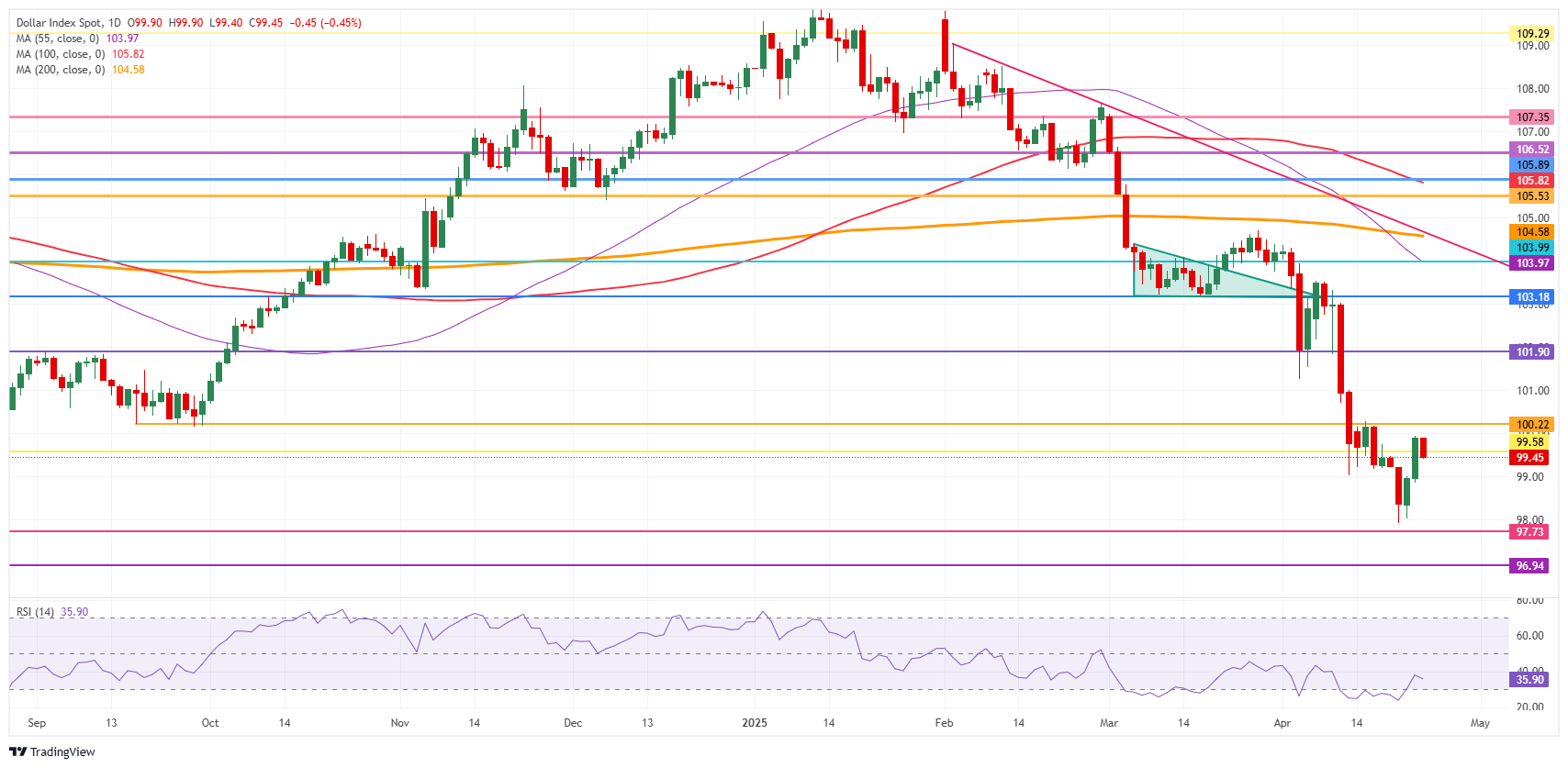US Dollar recovery stalls as optimism over US-China trade war deal wanes
- The US Dollar is dipping, with the DXY US Dollar Index down by around 0.50%.
- Markets are throwing in the towel again after Trump and Bessent said their administration hasn’t unilaterally offered to lower US tariffs on China.
- The US Dollar Index remains capped below the 100.00 round level.
The US Dollar Index (DXY), which tracks the performance of the US Dollar (USD) against six major currencies, trades on the back foot and is down 0.50% at the start of the European trading session on Thursday. The knee-jerk reaction comes after comments from United States (US) President Donald Trump and US Treasury Secretary Scott Bessent. Both individually said that no unilateral offer was made to China from the US to lower tariffs, while Trump said that reciprocal tariffs could be revisited if negotiations are not going the way the Trump administration wants them to go, Bloomberg reports.
On the economic calendar front, a very intensive trading day is ahead. Besides the weekly Jobless Claims, both the Chicago Fed Activity Tracker and the Kansas Fed Manufacturing Index are due to be released. The main focus, however, will likely be on the Durable Goods Orders data for March, with markets expecting orders to increase at a faster pace of 2%.
Daily digest market movers: Chunky agenda ahead
- At 12:30 GMT, the Chicago Fed National Activity Index for March is due. No forecast available, and the previous reading came in at 0.18.
- At the same time, the US Durable Goods for March and the Jobless Claims are due:
- Headline Durable Goods are expected to jump to 2% from 1% previously. The Orders without Cars and Transportation are expected to increase by 0.2%, less than the 0.7% advance seen a month earlier.
- Weekly Initial Jobless Claims are expected to tick higher to 221,000 from 215,000. Continuing Claims are expected to remain stable at around 1.88 million.
- Around 14:00 GMT, Existing Home Sales data for March will be published. Sales are expected to soften to 4.13 million against 4.26 million in February.
- Near 15:00 GMT, the Kansas Fed Manufacturing Activity Index for April is expected. No forecast available with the previous number at 1.
- Equities look bleak this Thursday, with minor losses in Europe. US futures are facing over 0.50% declines.
- The CME FedWatch tool shows the chance of an interest rate cut by the Federal Reserve in May’s meeting stands at 6.1% against a 93.9% probability of no change. The June meeting still has around a 58.7% chance of a rate cut.
- The US 10-year yields trade around 4.35% looking for direction as markets are facing some knee jerk reactions on the Trump comments.
US Dollar Index Technical Analysis: Knee-jerk again and again
The US Dollar Index (DXY) is backing off again after a two-day recovery. It looks like the DXY will start to consolidate, trading in a tight range between 100.00 and 98.00. Traders are likely to be fed up with these constant knee-jerk reactions and could opt to look for other places to put their money, with Gold as the preferred sweet spot.
On the upside, the DXY’s first resistance comes in at 99.58, acting up again as a false break occurred Wednesday and Thursday. Should the US Dollar be able to turn positive again, look for 100.22 with a break back above the 100.00 round level as a bullish signal of their return. A firm recovery would be a return to 101.90.
On the other hand, the 97.73 support is very close and could snap at any moment. Further below, a rather thin technical support comes in at 96.94, before looking at the lower levels of this new price range. These would be at 95.25 and 94.56, meaning fresh lows not seen since 2022.

US Dollar Index: Daily Chart
US-China Trade War FAQs
Generally speaking, a trade war is an economic conflict between two or more countries due to extreme protectionism on one end. It implies the creation of trade barriers, such as tariffs, which result in counter-barriers, escalating import costs, and hence the cost of living.
An economic conflict between the United States (US) and China began early in 2018, when President Donald Trump set trade barriers on China, claiming unfair commercial practices and intellectual property theft from the Asian giant. China took retaliatory action, imposing tariffs on multiple US goods, such as automobiles and soybeans. Tensions escalated until the two countries signed the US-China Phase One trade deal in January 2020. The agreement required structural reforms and other changes to China’s economic and trade regime and pretended to restore stability and trust between the two nations. However, the Coronavirus pandemic took the focus out of the conflict. Yet, it is worth mentioning that President Joe Biden, who took office after Trump, kept tariffs in place and even added some additional levies.
The return of Donald Trump to the White House as the 47th US President has sparked a fresh wave of tensions between the two countries. During the 2024 election campaign, Trump pledged to impose 60% tariffs on China once he returned to office, which he did on January 20, 2025. With Trump back, the US-China trade war is meant to resume where it was left, with tit-for-tat policies affecting the global economic landscape amid disruptions in global supply chains, resulting in a reduction in spending, particularly investment, and directly feeding into the Consumer Price Index inflation.

